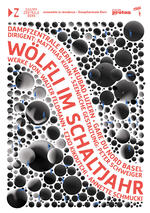
a co-production of Ensemble Proton Bern and Verein Wölfli & Musik
Ensemble music for Wölfli in the leap-year
Adolf Wölfli’s freedom is a result of utter captivity: from 1895 until his death in 1930, no less than 35 years, he was an inmate of the psychiatric hospital of Waldau near Bern and never saw the outside world again. Realised during this time, his ‘gesamtkunstwerk’ involving drawings, paintings, poetry and music came out of an imaginary world that was responsible for upholding a steady flux between reality and fiction. Wölfli formed the material into multi-facetted yet fanciful works of text, music and painting that were fascinatingly charged even by today’s standards. His symphonic texts are not only teeming with sound-painting, magic numbers, poems, songs and marches, but also direct references to music. “The above song is a 16-count march, precisely as the text implicates”, is what is found at various points in his gigantic almost 1000-page text work “From the Cradle to the Grave”.
One should therefore get to know Wölfli and his musical approach even better, namely in the leap-year 2016 – Wölfli was born on the 29th February 1864 – and the commissioning of three selected composers to write for chamber music Ensemble. This is a format that corresponds in size and constitution to that which Adolf Wölfli had ringing in his “mind’s ear”. Before becoming a resident at Waldau, Wölfli heard many different street musicians, village choirs, ländler bands and types of dance music working as a nomadic farmhand. These styles must have been a foundation for the internal coalescence of his music-text pieces. With that, “Wölfli in the leap year” will be an exciting new Wölfli production – new artistic constellations will be searched for, new facets of his work will be found, and excitement about the answers to artistic questions is already very much in the air.